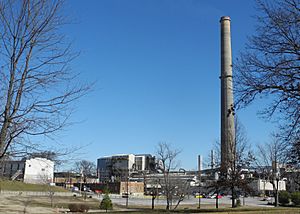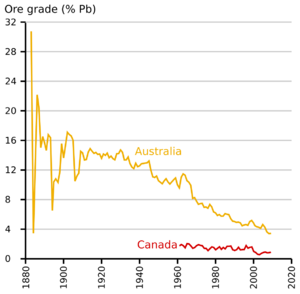Lead smelting facts for kids
Lead smelters are special factories where lead metal is made. This can happen in two main ways: by taking lead out of its natural rock (called primary production) or by recycling old lead products (called secondary production). Smelting uses heat and special chemicals to separate the pure lead from other materials.

When lead is made from its ore, it usually starts with a process called sintering. This is where concentrated lead ore is mixed with other materials like iron, limestone, and coke (a type of fuel). This mixture is then heated to prepare it for the next step.
Next, the prepared material goes into a large furnace, often a blast furnace. Inside, the intense heat and special gases help to separate the lead from the other elements. The melted lead, which is very heavy, sinks to the bottom. Lighter materials, called slag, float on top. The molten lead and slag flow out of the furnace and are then separated. The slag, which contains things like silica and zinc, might be thrown away or processed further to get other useful metals.
The lead that comes out of the blast furnace is called crude lead bullion. It still has some other metals mixed in, especially copper. To remove the copper, sulfur is added to the molten lead. This makes the copper form a layer called matte, which can be skimmed off. This matte, along with other impurities, is often sold to copper smelters to recover the copper.
After removing copper, the lead goes through another cleaning step called drossing. The lead is stirred and cooled, which makes impurities like lead oxides and other metals float to the top. This floating material, called dross, is skimmed off. The dross can then be processed to recover valuable non-lead parts. If the lead contains precious metals like silver or gold, a special method called the Parkes process is used to separate them.
Finally, the lead is refined even more to make it very pure. Special methods use heat or electricity to remove any last bits of unwanted metals. These leftover metals are often sold to other factories. The pure lead can then be used on its own or mixed with other metals to create different alloys, which are stronger or have special properties.
People who work in these lead production factories are also sometimes called smelters.
Contents
What are Lead Ores?
Lead is found in the Earth's crust as part of different minerals. The most common lead mineral is called Galena. Galena is mostly lead sulfide (PbS). During smelting, the sulfur is removed, and the lead is separated.
Other types of lead ores include Anglesite, Cerussite, Pyromorphite, Mimetite, and Wulfenite. Often, other metals like zinc and silver are found alongside lead in these ores.
Recycling Lead (Secondary Lead Processing)
Most of the lead used today comes from recycling old lead products. This is called secondary lead processing. Common items that are recycled for their lead content include old car batteries, cable coverings, pipes, and sheets of lead. Even small amounts of lead from things like solder or factory waste can be recovered. A lot of the recycled lead is used to make new batteries.
To recycle lead from a battery, the battery is first broken apart. The parts that contain lead are then separated. These lead-containing parts are melted down in special furnaces. For example, hard lead might go into a blast furnace, while fine particles go into a rotary furnace.
In the furnace, the lead parts are mixed with other materials like slag, scrap iron, and coke. The coke helps to melt the lead and separate it from impurities. The molten lead flows out of the furnace and can then be mixed with other metals like antimony or tin to make different ingots (blocks of metal).
Lead and Your Health
People have been making lead for thousands of years. Unfortunately, this has sometimes caused health problems because lead can be harmful. Even though we've known about lead poisoning for a long time, we only recently understood that even very small amounts of lead can be bad for your health. There is no known safe amount of lead exposure.
Health organizations like the US Centers for Disease Control and Prevention (CDC) and the World Health Organization (WHO) say that a certain level of lead in the blood is a concern. However, lead can still affect development and health even at lower levels, especially in children.
Lead smelters that don't have good pollution controls can cause environmental problems. They can release lead into the air and soil, which can lead to higher lead levels in people living nearby. This is especially a problem for children who grow up close to these factories.
A Brief History of Lead Smelting
The earliest known lead objects were found in Turkey and date back to about 6500 BC. In ancient times, lead was melted in simple outdoor fires or furnaces using lead ore and charcoal.
Even though lead was discovered early, it wasn't as important as other metals like copper or iron because it's too soft for weapons or strong structures. However, because it's easy to melt and shape, it was widely used in ancient Ancient Greece and Ancient Rome. Romans used lead for water pipes, storage, and even as a mortar in buildings.
Evidence from ice cores in places like Greenland and the Swiss Alps shows that lead pollution in the atmosphere increased during Roman times. This pollution was often linked to lead and silver mining. For example, high lead levels in ice cores from 1170 to 1216 CE match records of lead and silver production in England.
In the 16th century, a scholar named Georgius Agricola wrote a detailed book called De Re Metallica. It described how lead was smelted in Europe at that time, from simple open fires to more advanced blast furnaces.
In the USA, there were many lead smelting companies that operated from the 1930s to the 1960s. Some of these old sites might still have dangerous levels of lead in the soil nearby.
Historic Lead Smelting Locations
Many places around the world have a history of lead mining and smelting. Here are a few examples:
- Asia: Gazimursky Zavod
- Australia: Boolaroo, New South Wales, Argenton, New South Wales, Cockle Creek Smelter
- Europe: Grinton Smelt Mill (England), Milford, Derbyshire (England), Mendip Hills (England), Wirksworth (England), Upper Harz (Germany), Copșa Mică works (Transylvania), Rammelsberg (Germany), Ballycorus Leadmines (Ireland)
- North America: Noonday Camp, California (USA), Tri-State district (USA), Southeast Missouri Lead District (USA), ASARCO Murray, Utah (USA), Midvale, Utah (USA), International Smelting and Refining Company Tooele (USA), Bunker Hill Mine and Smelting Complex (Idaho, USA), Butte, Montana (USA), Harbor Island (Seattle) (USA), Sinsinawa, Wisconsin (USA), East Chicago, Indiana (USA), Priest Mine (Canada), Cerro Gordo Mines (USA)
Active Lead Smelting Locations Today

Lead smelting still happens in many parts of the world. Here are some active sites:
- Africa: Kitwe, Zambia
- Australia: Nyrstar Port Pirie, Broken Hill, New South Wales, Mount Isa Mines
- Asia: Chanderiya Smelter Complex in Rajasthan, India
- Europe: Rönnskär copper smelter (Sweden), Bergsöe lead smelter (Sweden), Tara Mine (Ireland), KCM in Plovdiv (Bulgaria)
- North America: Doe Run Resources Corporation (USA), Hayden Smelter (Arizona, USA), Belledune, New Brunswick (Canada), Red Dog mine (Alaska, USA), Teck Trail Operations (BC, Canada)
- South America: La Oroya (Peru), Cerro de Pasco (Peru)
See also
- Aluminium smelting
- Cast iron
- Zinc smelting


